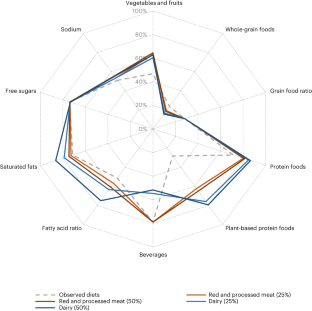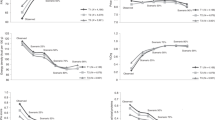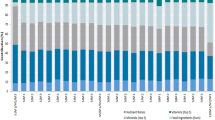Abstract
Dietary guidelines emphasize the consumption of plant protein foods, but the implications of replacing animal with plant sources on a combination of diet sustainability dimensions are unknown. Using a combination of data from a national nutrition survey, greenhouse gas emissions from dataFIELD and relative risks from the Global Burden of Disease Study 2017, we assess the impact of partially substituting red and processed meat or dairy with plant protein foods in Canadian self-selected diets on nutrition, health and climate outcomes. The substitutions induced minor changes to the percentage of the population below requirements for nutrients of concern, but increased calcium inadequacy by up to 14% when dairy was replaced. Replacing red and processed meat or dairy increased life expectancy by up to 8.7 months or 7.6 months, respectively. Diet-related greenhouse gas emissions decreased by up to 25% for red and processed meat and by up to 5% for dairy replacements. Co-benefits of partially substituting red and processed meat with plant protein foods among nutrition, health and climate outcomes are relevant for reshaping consumer food choices in addressing human and planetary health.
This is a preview of subscription content, access via your institution
Access options
Access Nature and 54 other Nature Portfolio journals
Get Nature+, our best-value online-access subscription
$29.99 / 30 days
cancel any time
Subscribe to this journal
Receive 12 digital issues and online access to articles
$119.00 per year
only $9.92 per issue
Buy this article
- Purchase on Springer Link
- Instant access to full article PDF
Prices may be subject to local taxes which are calculated during checkout



Similar content being viewed by others
Data availability
Access to the 2015 CCHS—Nutrition microdata files is restricted to accredited researchers. To become accredited, individuals must apply for access by submitting a project proposal to Statistics Canada: https://www.statcan.gc.ca/en/microdata/data-centres/access. The authors declare that all other data used in this study are available as specified throughout the article and Supplementary Information. Source data are provided with this paper.
Code availability
SAS and R code (health outcomes) are publicly available and can be accessed at https://doi.org/10.5281/zenodo.10480135 (ref. 40).
References
Willits-Smith, A., Aranda, R., Heller, M. C. & Rose, D. Addressing the carbon footprint, healthfulness, and costs of self-selected diets in the USA: a population-based cross-sectional study. Lancet Planet. Health 4, e98–e106 (2020).
Seves, S. M., Verkaik-Kloosterman, J., Biesbroek, S. & Temme, E. H. M. Are more environmentally sustainable diets with less meat and dairy nutritionally adequate? Public Health Nutr. 20, 2050–2062 (2017).
Biesbroek, S. et al. Reducing our environmental footprint and improving our health: greenhouse gas emission and land use of usual diet and mortality in EPIC-NL: a prospective cohort study. Environ. Health 13, 27 (2014).
Scarborough, P., Allender, S., Clarke, D., Wickramasinghe, K. & Rayner, M. Modelling the health impact of environmentally sustainable dietary scenarios in the UK. Eur. J. Clin. Nutr. 66, 710–715 (2012).
Temme, E. H. M. et al. Greenhouse gas emission of diets in the Netherlands and associations with food, energy and macronutrient intakes. Public Health Nutr. 18, 2433–2445 (2014).
Rose, D., Willits-Smith, A. M. & Heller, M. C. Single-item substitutions can substantially reduce the carbon and water scarcity footprints of US diets. Am. J. Clin. Nutr. 115, 378–387 (2022).
Vieux, F., Soler, L. G., Touazi, D. & Darmon, N. High nutritional quality is not associated with low greenhouse gas emissions in self-selected diets of French adults. Am. J. Clin. Nutr. 97, 569–583 (2013).
Canada’s Dietary Guidelines: For Health Professionals and Policy Makers (Health Canada, 2019); https://food-guide.canada.ca/en/guidelines/
Auclair, O. & Burgos, S. A. Protein consumption in Canadian habitual diets: usual intake, inadequacy, and the contribution of animal- and plant-based foods to nutrient intakes. Appl. Physiol. Nutr. Metab. 46, 501–510 (2020).
Auclair, O., Han, Y. & Burgos, S. A. Consumption of milk and alternatives and their contribution to nutrient intakes among Canadian adults: evidence from the 2015 Canadian Community Health Survey—Nutrition. Nutrients. 11, 1948 (2019).
Salomé, M. et al. Substituting meat or dairy products with plant-based substitutes has small and heterogeneous effects on diet quality and nutrient security: a simulation study in French adults (INCA3). J. Nutr. 151, 2435–2445 (2021).
Interim policy on the use of expired interim marketing authorizations related to food fortification. Health Canada https://www.canada.ca/en/health-canada/services/food-nutrition/legislation-guidelines/policies/interim-policy-on-use-expired-interim-marketing-authorizations-related-food-fortification.html#a61 (2022).
Pawlak, R., Berger, J. & Hines, I. Iron status of vegetarian adults: a review of literature. Am. J. Lifestyle Med. 12, 486–498 (2018).
Harrison, S., Lemieux, S. & Lamarche, B. Assessing the impact of replacing foods high in saturated fats with foods high in unsaturated fats on dietary fat intake among Canadians. Am. J. Clin. Nutr. 115, 877–885 (2022).
Astrup, A. et al. Saturated fats and health: a reassessment and proposal for food-based recommendations: JACC state-of-the-art review. J. Am. Coll. Cardiol. 76, 844–857 (2020).
Givens, D. I. Saturated fats, dairy foods and cardiovascular health: no longer a curious paradox? Nutr. Bull. 47, 407–422 (2022).
Patterson, E., Eustachio Colombo, P., Milner, J., Green, R. & Elinder, L. S. Potential health impact of increasing adoption of sustainable dietary practices in Sweden. BMC Public Health 21, 1332 (2021).
Frehner, A., De Boer, I. J. M., Muller, A., Van Zanten, H. H. E. & Schader, C. Consumer strategies towards a more sustainable food system: insights from Switzerland. Am. J. Clin. Nutr. 115, 1039–1047 (2022).
Vieux, F. et al. More sustainable European diets based on self-selection do not require exclusion of entire categories of food. J. Clean. Prod. 248, 119298 (2020).
Vanderlee, L. et al. Meat-reduced dietary practices and efforts in 5 countries: analysis of cross-sectional surveys in 2018 and 2019. J. Nutr. 152, 57S–66S (2022).
Usual dietary intakes: the NCI method. National Cancer Institute https://epi.grants.cancer.gov/diet/usualintakes/method.html (2018).
Stanton, A. V. et al. 36-fold higher estimate of deaths attributable to red meat intake in GBD 2019: is this reliable? Lancet 399, e23–e26 (2022).
Afshin, A. et al. Health effects of dietary risks in 195 countries, 1990–2017: a systematic analysis for the Global Burden of Disease Study 2017. Lancet 393, 1958–1972 (2019).
Hall, K. D. et al. Quantification of the effect of energy imbalance on bodyweight. Lancet 378, 826–837 (2011).
Reference guide to understanding and using the data: 2015 Canadian Community Health Survey—Nutrition. Health Canada https://www.canada.ca/en/health-canada/services/food-nutrition/food-nutrition-surveillance/health-nutrition-surveys/canadiancommunity-health-survey-cchs/reference-guide-understanding-using-data-2015.html#a1.1.3 (2017).
Canadian Nutrient File (Health Canada, accessed 24 October 2019); https://food-nutrition.canada.ca/cnf-fce/index-eng.jsp
Auclair, O. & Burgos, S. A. Carbon footprint of Canadian self-selected diets: comparing intake of foods, nutrients, and diet quality between low- and high-greenhouse gas emission diets. J. Clean. Prod. 316, 128245 (2021).
Brassard, D. et al. Development of the Healthy Eating Food Index (HEFI)-2019 measuring adherence to Canada’s Food Guide 2019 recommendations on healthy food choices. Appl. Physiol. Nutr. Metab. 47, 595–610 (2022).
Dietary reference intakes tables. Health Canada https://www.canada.ca/en/health-canada/services/food-nutrition/healthy-eating/dietary-reference-intakes/tables.html#def (2023).
Health Canada’s proposed changes to the core nutrients declared in the Canadian nutrition facts table. Health Canada https://www.canada.ca/en/health-canada/services/food-nutrition/public-involvement-partnerships/technical-consultation-proposedchanges-core-nutrients-declared-canadian-nutrition-facts-table/consultation.html (2014).
Tooze, J. A. et al. A new statistical method for estimating the usual intake of episodically consumed foods with application to their distribution. J. Am. Diet. Assoc. 106, 1575–1587 (2006).
Advice on vitamin and mineral supplementation. Health Canada https://food-guide.canada.ca/en/applying-guidelines/advice-vitamin-mineral-supplementation/ (2022).
Garriguet, D. Combining nutrient intake from food/beverages and vitamin/mineral supplements. Health Rep. 21, 71–84 (2010).
Miller, B. G. & Hurley, J. F. Life table methods for quantitative impact assessments in chronic mortality. J. Epidemiol. Community Health 57, 200–206 (2003).
Eustachio Colombo, P. et al. Pathways to “5-a-day”: modeling the health impacts and environmental footprints of meeting the target for fruit and vegetable intake in the United Kingdom. Am. J. Clin. Nutr. 114, 530–539 (2021).
Table 17-10-0005-01. Population Estimates on July 1st, by Age and Sex (Statistics Canada, 2022); https://www150.statcan.gc.ca/t1/tbl1/en/tv.action?pid=1710000501
Heller, M. C., Willits-Smith, A., Meyer, R., Keoleian, G. A. & Rose, D. Greenhouse gas emissions and energy use associated with production of individual self-selected US diets. Environ. Res. Lett. 13, 044004 (2018).
Vergé, X. P. C. et al. Carbon footprint of Canadian dairy products: calculations and issues. J. Dairy Sci. 96, 6091–6104 (2013).
Hallström, E. et al. Dietary environmental impacts relative to planetary boundaries for six environmental indicators—a population-based study. J. Clean. Prod. 373, 133949 (2022).
Auclair, O., Eustachio Colombo, P., Milner, J. & Burgos, S. A. oliviaauclair/Auclair-et-al_Replacing-Protein-Foods. Zenodo https://doi.org/10.5281/zenodo.10480135 (2024).
Moberg, E., Karlsson Potter, H., Wood, A., Hansson, P.-A. & Röös, E. Benchmarking the Swedish diet relative to global and national environmental targets—identification of indicator limitations and data gaps. Sustainability 12, 1407 (2020).
Acknowledgements
The analysis presented in this paper was conducted at the McGill–Concordia Laboratory of the Quebec Inter-University Centre for Social Statistics, which is part of the Canadian Research Data Centre Network. The services and activities provided by the McGill–Concordia Laboratory of the Quebec Inter-University Centre for Social Statistics are made possible by the financial or in-kind support of the Social Sciences and Humanities Research Council, the Canadian Institutes of Health Research, the Canadian Foundation for Innovation, Statistics Canada and McGill University. The views expressed in this paper do not necessarily represent that of the Canadian Research Data Centre Network or its partners. We thank D. Garriguet of Health Canada for providing guidance with the NCI method, I. Michaud of Statistics Canada for guidance with multiple comparison testing procedures and D. Forest of Statistics Canada for vetting the data. O.A. is supported by a doctoral scholarship from the Social Sciences and Humanities Research Council of Canada, a Graduate Excellence Fellowship from McGill University and supplementary funding from a Natural Sciences and Engineering Research Council of Canada grant to S.A.B. (RGPIN-2017-05007).
Author information
Authors and Affiliations
Contributions
O.A. conducted the analyses and wrote the article. O.A. and S.A.B. conceptualized the study, and analysed and interpretated the data. P.E.C. and J.M. provided code for the health analyses and aided with interpretation of the results. All authors revised and approved the final manuscript.
Corresponding author
Ethics declarations
Competing interests
O.A., P.E.C. and J.M. declare no competing interests. S.A.B. reports receiving honoraria as a speaker in 2019 and grant funding for research unrelated to this paper from Dairy Farmers of Canada.
Peer review
Peer review information
Nature Food thanks Jelena Meinilä, Darel Wee Kiat Toh and the other, anonymous, reviewer(s) for their contribution to the peer review of this work.
Additional information
Publisher’s note Springer Nature remains neutral with regard to jurisdictional claims in published maps and institutional affiliations.
Extended data
Supplementary information
Supplementary Information
Supplementary Methods and Tables 1–8.
Source data
Source Data Fig. 1
Adherence to Canada’s Food Guide for observed and modelled diets.
Source Data Fig. 2
Changes in the percentage of the population below requirements for nutrients of concern for modelled relative to observed diets.
Source Data Fig. 3
Changes in the percentage of the population above recommendations for nutrients to limit for modelled relative to observed diets.
Rights and permissions
Springer Nature or its licensor (e.g. a society or other partner) holds exclusive rights to this article under a publishing agreement with the author(s) or other rightsholder(s); author self-archiving of the accepted manuscript version of this article is solely governed by the terms of such publishing agreement and applicable law.
About this article
Cite this article
Auclair, O., Eustachio Colombo, P., Milner, J. et al. Partial substitutions of animal with plant protein foods in Canadian diets have synergies and trade-offs among nutrition, health and climate outcomes. Nat Food 5, 148–157 (2024). https://doi.org/10.1038/s43016-024-00925-y
Received:
Accepted:
Published:
Issue Date:
DOI: https://doi.org/10.1038/s43016-024-00925-y



